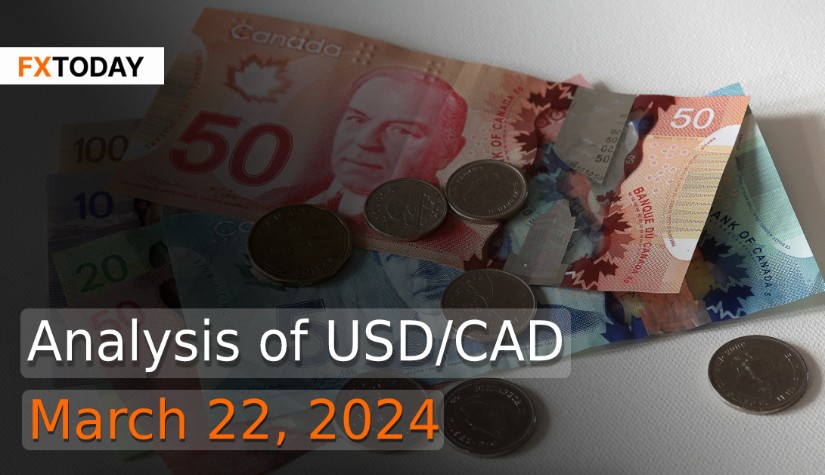BoC Mulls Rate Cuts; U.S. Dollar Strengthens Amid Economic Resilience
The Bank of Canada (BoC) deliberated over potential rate cuts during their recent meeting, indicating a possible easing of rates this year if economic conditions align with forecasts. This discussion, disclosed in minutes preceding the March 6 rate announcement, marked the first time the BoC specified a timeline for potential rate adjustments from their current 22-year high of 5%.
The BoC anticipates weak growth in the first quarter, gradually improving to less than 1% annualized growth by the end of the year, alongside a projection of inflation hovering around 3% in the first half of 2024 before easing to 2.5% later in the year. Nevertheless, Canada's inflation rate dipped to 2.8% in February, the lowest in eight months, with the decline mainly attributed to softer price growth in food and reductions in cellular and internet service prices.
In response to the housing affordability crisis, Canada's federal budget, scheduled for next month, is likely to allocate significant funds towards housing initiatives. This crisis, driven by a rapidly growing immigrant population outpacing available housing, has led to elevated inflation and interest rates, exacerbating rent and mortgage costs.
The potential onset of lower interest rates is expected to intensify competition among Canadian banks for customer deposits. This shift is anticipated to redirect funds from high-yielding fixed income products to riskier investments, posing challenges for banks reliant on stable customer deposits for funding. Canadian banks have taken measures to preserve profits amid rising loan loss provisions, but analysts foresee potential earnings declines followed by growth later in the year.
The U.S. dollar continued to strengthen for a second consecutive week, buoyed by investor perceptions of high U.S. interest rates and their economic resilience. Market sentiment favoring the dollar was further reinforced by the Swiss National Bank's unexpected interest rate cut, highlighting the attractiveness of the greenback amidst robust U.S. economic growth. Positive indicators from the U.S. economy, including a decrease in new unemployment benefit claims and a notable increase in sales of previously owned homes, underscored the nation's strong economic performance in the first quarter.
Despite stable business activity, signs of increasing inflation emerged, with prices rising across various sectors. While manufacturing reached a 21-month high, the services sector experienced a slight cooling. The overall economic outlook for the United States remains positive, with steady growth anticipated despite inflationary pressures. Additionally, U.S. new vehicle sales are expected to rise in March, driven by strong demand and improved vehicle availability despite ongoing supply chain challenges. This surge in sales has led to increased competition among manufacturers and dealers, resulting in significant discounts and a shift towards higher sales volumes over profit margins.
Meanwhile, the U.S. current account deficit narrowed to its lowest level in nearly three years in the fourth quarter of last year. Notably, the United States has become a net exporter of crude oil and fuel, although imports still outweigh exports in goods trade.
In monetary policy, the U.S. Federal Reserve opted to maintain its benchmark interest rates but reaffirmed intentions to implement three quarter-percentage point cuts by the end of 2024. Despite slower progress towards inflation targets, the Fed remains optimistic about economic growth, with expectations of a 2.1% expansion in 2024.
However, concerns linger over the prolonged inversion of the Treasury yield curve, a traditional indicator of impending recession, despite the economy showing no signs of contraction. Persistent inversion of the Treasury yield curve, particularly between two-year and 10-year bonds, suggests a looming recession, a signal observed since early July 2022, surpassing a previous record set in 1978.
This inversion, known as a 2/10 curve inversion, historically precedes economic downturns, indicating higher short-term yields amid expectations of interest rate hikes to combat inflation, alongside anticipated future rate cuts to stimulate a weakening economy. Inverted yield curves typically dampen economic activity and financial markets by increasing borrowing costs and discouraging long-term investment. Despite this warning sign, market expectations for U.S. rate cuts have risen slightly, with around 80 basis points of cuts anticipated for the year, notably lower than earlier projections of approximately 160 basis points. Consequently, it is anticipated that the USD/CAD currency pair will maintain stability within a limited range, attributed to the minimal disparity in returns between the two nations, although there may be a continuing trend of the U.S. dollar gaining strength during this period.
Data for Technical Analysis (30Min) CFD USD/CAD
Resistance : 1.3564, 1.3566, 1.3569
Support : 1.3558, 1.3556, 1.3553
30Min Outlook
Source: Investing.com
Buy/Long 1 If the support at the price range 1.3553 - 1.3558 is touched, but the support at 1.3558 cannot be broken, the TP may be set around 1.3566 and the SL around 1.3551, or up to the risk appetite.
Buy/Long 2 If the resistance can be broken at the price range of 1.3564 - 1.3569, TP may be set around 1.3573 and SL around 1.3556, or up to the risk appetite.
Sell/Short 1 If the resistance at the price range 1.3564 - 1.3569 is touched, but the resistance 1.3564 cannot be broken, the TP may be set around 1.3558 and the SL around 1.3571, or up to the risk appetite.
Sell/Short 2 If the support can be broken at the price range of 1.3553 - 1.3558, TP may be set around 1.3550 and SL around 1.3566, or up to the risk appetite.
Pivot Points Mar 22, 2024 03:29AM GMT
|
Name
|
S3
|
S2
|
S1
|
Pivot Points
|
R1
|
R2
|
R3
|
|---|---|---|---|---|---|---|---|
| Classic | 1.355 | 1.3553 | 1.3558 | 1.3561 | 1.3566 | 1.3569 | 1.3573 |
| Fibonacci | 1.3553 | 1.3556 | 1.3558 | 1.3561 | 1.3564 | 1.3566 | 1.3569 |
| Camarilla | 1.3559 | 1.356 | 1.3561 | 1.3561 | 1.3562 | 1.3563 | 1.3564 |
| Woodie's | 1.355 | 1.3553 | 1.3558 | 1.3561 | 1.3566 | 1.3569 | 1.3573 |
| DeMark's | - | - | 1.3559 | 1.3561 | 1.3567 | - | - |
Sources: Investing 1, Investing 2
















